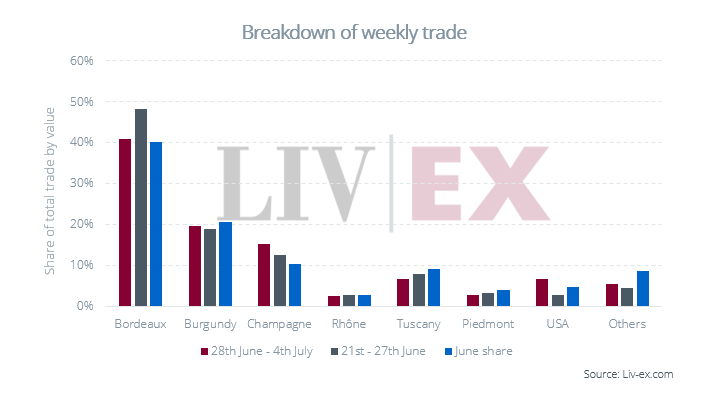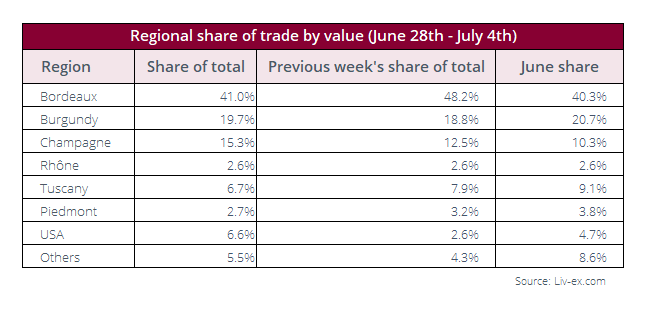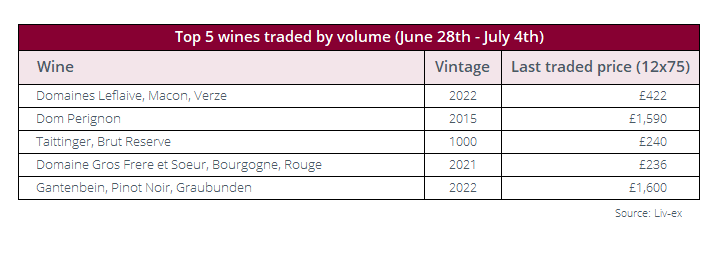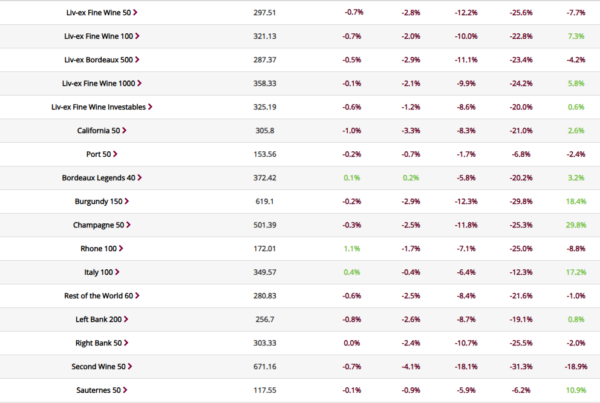- Bordeaux led weekly trade, followed by Burgundy and Champagne.
- While wines from Bordeaux and Burgundy took the lion’s share of trade value, two Champagnes were amongst the top traded.
- This week, Liv-ex published a Market Update on the advantages of buying the dip in Bordeaux and an analysis of the indices in June.
What’s happening in the secondary market?
Despite falling from its strong close at 48.2% last week, Bordeaux continued to lead the market this week, taking 41.0% of trade by value. While three of the top-traded wines by value hail from the region, the top-traded wines by volume comprise only Champagne and Burgundy. Burgundy came in second with 20.8% of trade share, up from 18.8% last week.
With Dom Perignon 2015 being released on Monday, Champagne saw renewed demand. While the region took only 10% of trade share over June, it composed 15.7% of traded value this week.
Despite demand for the 2021 vintages of Tenuta san Guido’s Sassicaia and Ornellaia, and the 2016 vintage of Bruno Giacosa Barolo Falletto Vigna Le Rocche Riserva, Tuscany and Piedmont both saw decreases in trade share,
The USA more than doubled its trade share, taking 5.8% this week, up from last week’s 2.6%. As expected, California drove the region, with several vintages of Screaming Eagle Sauvignon Blanc and Harlan Estate changing hands.
What were this week’s top-traded wines?
All 5 of this week’s top-traded wines by value hailed from older vintages. Château Latour 2010 took the lion’s share. It last traded at £8,408 per 12×75, an 8.6% discount to its Market Price. Initially released at £11,000, this most recent trade marks the wine’s lowest recorded transaction price. Retasting the 2010s in 2020, Neal Martin (Vinous) awarded Château Latour a perfect 100-point score.
Château Latour 2010 trades
By contrast, Petrus 1995, entering the market at £4,625, has appreciated by more than 500%. The most recent trade occurred 6.8% above its Market Price of £29,519. A pack of three magnums of Petrus 1995 also traded this week for £17,200. The magnums came at a 16.5% premium (ml for ml) to the Market Price for the 75cl. The wine’s strong performance can be attributed to its relative scarcity. Not only is production of Petrus limited, but it is also tightly allocated and in high demand, so older vintages will likely be in the hands of final consumers.
While Domaine de la Romanée-Conti has similarly low production numbers, the wines see less frequent trade on the market than Petrus. In a recent technical analysis, we commented on the downward trajectory of our DRC index. La Tache 2006 traded this week 11.1% below its Market Price, while the wine itself is down 10% month-on-month. Even so, its Market Price has more than quadrupled since its initial release into the market.
Wines from Château Lafite Rothschild consistently places amongst the top traded on the secondary market. This week, 9 different vintages changed hands, with the 2009 proving the most popular. High demand for Lafite Rothschild, evidenced by the chart below, has allowed for the brand’s relative stability in an uncertain market.
Château Lafite Rothschild 2009 trades
Top-traded wines by volume
Following its release on Monday, Dom Perignon 2015 took second place amongst the most traded wines by value. While it was released with a recommended selling price of £1,750, it is currently trading 9.1% below at £1,590. The release also appears to have reinvigorated interest in other vintages of Dom Perignon, with wines from 4 other vintages changing hands.
All 5 of the top-traded wines by volume were priced under £2,000. Month-on-month, overall trade value is down by 4.2%, while traded volume is down by only 2.8%. This serves as an indication that less expensive wines are proving increasingly popular on the secondary market.
Weekly insights recap
This week, Liv-ex members received a Market Update looking into the advantages of buying the Bordeaux dip. An update on the major Liv-ex indices has also been published, and is now available for all to read.
Liv-ex analysis is drawn from the world’s most comprehensive database of fine wine prices. The data reflects the real-time activity of Liv-ex’s 620+ merchant members from across the globe. Together they represent the largest pool of liquidity in the world – currently £100m of bids and offers across 20,000 wines.









